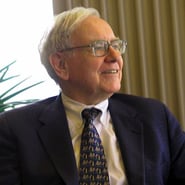

 Popular Posts: 9 Quality Dividend Stocks Purchased for a Roth IRA20 Best Dividend Stocks for 2013 and BeyondXOM – Why Exxon is the Best Oil Buy for Warren Buffett Recent Posts: Warren Buffett's Favorite Exercise Aids Dividend Investors 9 Quality Dividend Stocks Purchased for a Roth IRA XOM – Why Exxon is the Best Oil Buy for Warren Buffett View All Posts
Popular Posts: 9 Quality Dividend Stocks Purchased for a Roth IRA20 Best Dividend Stocks for 2013 and BeyondXOM – Why Exxon is the Best Oil Buy for Warren Buffett Recent Posts: Warren Buffett's Favorite Exercise Aids Dividend Investors 9 Quality Dividend Stocks Purchased for a Roth IRA XOM – Why Exxon is the Best Oil Buy for Warren Buffett View All Posts 
Warren Buffett
I like learning from super investors of the world. When I think about super investors, the first thought that comes to mind is Warren Buffett.
Buffett's favorite exercise is going to a certain year, looking at the top 10 – 20 companies by market capitalization, and then determining whether they are still around or not. This fits in perfectly with the long-term investment strategy of the Oracle of Omaha, where he tries to select companies that are still going to be around and doing well 15 – 20 years into the future.
For example, using the Standard & Poor’s, I looked at the top ten companies in the index as of 1983:
| YEAR | COMPANY | % | MARKET | % OF |
| 8312 | Int’l Bus. Machines (IBM) | 1 | $74,346 | 6.09% |
| 8312 | Exxon Corp (XOM) | 2 | $32,114 | 2.63% |
| 8312 | General Electric (GE) | 3 | $26,626 | 2.18% |
| 8312 | General Motors (GM) | 4 | $23,414 | 1.92% |
| 8312 | American Tel & Tel (T) (new) | 5 | $17,234 | 1.41% |
| 8312 | Stand’d Oil,Indiana | 6 | $14,848 | 1.22% |
| 8312 | Schlumberger, Ltd (SLB) | 7 | $14,503 | 1.19% |
| 8312 | Sears, Roebuck | 8 | $13,150 | 1.08% |
| 8312 | Eastman Kodak | 9 | $12,603 | 1.03% |
| 8312 | duPont(EI)deNemours | 10 | $12,405 | 1.02% |
Thirty years later, only two of these companies went bankrupt (Eastman Kodak (EKDKQ) and General Motors (GM)), while the rest did well for their shareholders. The past 30 years were a tumultuous period for all of the companies however, as it was characterized by a flurry of mergers, acquisitions, reorganizations and changing of business focus.
For example, at one point in 1993, International Business Machines (IBM) was very close to falling on the wrong path. In another example, Sears had acquired and then spun-off a handful of companies before merging with Kmart in 2004 to form Sears Holdings (SHLD). An investor who put $1000 equally in each of those ten leading blue chips at the time, did very well 30 years later if they held patiently all the stock they received and reinvested their dividends.
The AT&T you see listed is the long-distance operations of the original Ma Bell, after the split of the 7 regional baby bells. The company was acquired by SBC (one of the 7 baby bells that were split from Ma Bell in 1984) in 2005. Subsequently, SBC changed its name to the AT&T (T) we know today.
Exxon managed to merge with Mobil in 1999, and formed Exxon Mobil (XOM). This was quite interesting, because both companies originated from the break-up of Standard Oil Trust in 1911. You might notice Standard Oil of Indiana in the list, which was also a descendant of the Standard Oil Trust, and was later renamed Amoco. The company was acquired by BP (BP) in 1998.
In my investing, I look at the dividend kings, not as a list of recommendation per se, but for learning perspective. It is always a good idea to try and understand how some companies managed to boost earnings, so that they could increase dividends to shareholders for over 50 years in a row.
For example, companies like Procter & Gamble (PG) were able to use their scale to their advantage in the new medium of television starting in the 1950s. Then the company managed to ride the wave of prosperity after the fall of the Soviet Union in the 1990s.
Full Disclosure: Long IBM, XOM, PG,
No comments:
Post a Comment